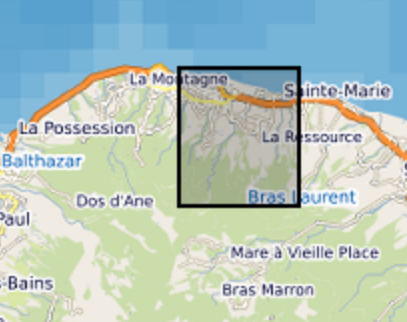dataset
Type of resources
Available actions
Topics
INSPIRE themes
Keywords
Contact for the resource
Provided by
Years
Formats
Representation types
Update frequencies
status
Scale
-

The overall objective of the ESPOIRS project is to obtain a better understanding of the variability, statistical properties and formation mechanisms of intense tropical precipitation at regional and local scales. ESPOIRS is thus interested in the entire life cycle of precipitation at several space-time scales. * Through the analysis of the distribution of the large-scale humidity field which drives the formation of precipitation at the regional scale using a GNSS network. * Through the characterization of internal (dynamics, microphysics) and external (interactions with the relief) processes, which drive the formation and life cycle of extreme weather events at the local scale => transportable Polarized Doppler X-band precipitation radar.
-

Le radar mini-BASTA est un radar nuage (95GHz) dédié à l’étude des nuages et du brouillard. Le radar mesure l’énergie rétrodiffusée par les hydrométéores, cette énergie peut donc être reliée à la quantité d’eau contenue dans le nuage (liquide et glace). Il fonctionne en routine quotidiennement sur le site de l’observatoire du Maïdo, sur l'Ile de La Réunion. Ce jeu de données est au niveau L0, et les données sont non calibrées. Paramètre principal: Profil vertical de réflectivité radar, mesure du décalage Doppler. Contexte de la mesure: observation routine.
-

The station is managed by the Observatoire de la Zone Critique de la Réunion (OZC-R) from Observatoire des Sciences de l'Univers de La Réunion (OSU-Réunion, Université de La Réunion), and located at 80m asl at the Reunion University. Rainwater is monthly collected (PALMEX rain collector) for δ18O and δ2H water isotopes analysis from 2001. Analyses are carried out at the International Atomic Energy Agency as part of the global network for measuring isotopes in precipitation (GNIP-IAEA).
-

Elevational Transect on the West side of the Piton des Neiges. Implementation of small permanents plots every 200 m of height between 750 and 2350 m. Differents biotics and abiotics parameters are observed on plots: - Climatic variables (T, RH) - Physico-chemical analyses of grounds - Inventories of vegetation, arthropods
-

The ressource describes the dataset obtained by deploying the GAMIC GMWR-25-DP RADAR in the South of Reunion Island, in Saint Joseph.
-

Instrumentation in river. The parameters are the following ones: - water level (available) - Temperature (available) - Conductivity (to set up) - Turbidity (available) - pH / dissolved oxygen / Potential oxydo-reduction (to set up) Laboratoire Géosciences Réunion – IPGP
-

This dataset encompasses model outputs generated by the Weather Research and Forecasting (WRF) regional climate model. A high-resolution (~1km) downscaling simulation was performed over two tropical islands, Reunion and Mauritius, situated in the South-West Indian Ocean (SWIO), with initial and boundary conditions provided by the ERA5 reanalysis with a global resolution of 0.25° × 0.25°. The simulation used three nested domains sequentially configured with spatial resolutions of 9, 3, and 1km, respectively, with a downscaling ratio of 3. The physical configurations of this simulation were determined through previous modeling studies and sensitivity tests. The published simulation data currently covers a period of 10 years, starting from 1991 (with the possibility to be extended to 30 years). Over 60 output variables were selected for publication with open access, including those related to the intermittent energy resources (e.g., surface solar radiation and its direct/diffuse components, wind speed/direction at multiple vertical levels, and precipitation, of interest for the run-off-river hydropower), as well as the widely used climatic/meteorological variables (e.g., temperature, pressure, humidity, etc.) at a temporal resolution varying from a day up to 30 minutes. All the data are available through an open-access data server, where an intelligent algorithm is applied to simplify the download process for data users. For the first time, a long-term, high-resolution climate/meteorological dataset covering Reunion and Mauritius has been simulated and published as open-access data, yielding substantial benefits to studies on climate modeling, weather forecasting, and even those related to climate change in the SWIO region. In particular, this dataset will enable a better understanding of the temporal and spatial characteristics of intermittent climate-related energy resources, consequently facilitating their implementation towards a green and low-carbon future.
-

Elevational Transect on the East side of the Piton des Neiges. Implementation of small permanents plots every 200 m of height between 350 m and 2950 m. Differents biotics and abiotics parameters are observed on plots: - Climatic variables (T, RH) - Physico-chemical analyses of grounds - Vegetation and arthropods inventories...
-

Meteo station Vantage Pro 2 Recorded parameters: - Wind speed and direction - Pluviometer - Temperature - Humidity (inside shelter) and outside - Barometric pressure Data transmission towards station of acquisition via WiFi. This station is connected on a PC Windows software.
-

Weekly and monthly physico-chemical water samples of "Rivière des Pluies" watershed, Reunion Island
 Geosur
Geosur